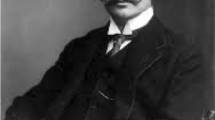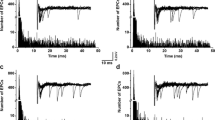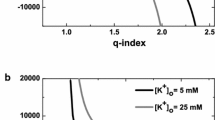Abstract
WHEN an impulse arrives at a motor end-plate, it causes acetylcholine to be released at numerous ‘key points’ and in discrete quanta, each containing a large number of molecules1. The discharge of each quantal unit is an all-or-none event, and its success or failure is subject to independent statistical fluctuation. Its chances can be altered by various means, for example, by changing the ionic environment. Even under normal conditions, the probability of an individual ‘quantum response’ appears to be less than unity; that is, a nerve impulse excites at each junction only a fraction of the whole synaptic population. By lowering the calcium and raising the magnesium concentration, the chance of any one unit responding to a nerve impulse can be reduced to a very low value, and under these conditions, which apply to all the experiments described below, the statistical nature of the transmission process can be demonstrated most effectively.
Similar content being viewed by others
References
Fatt, P., and Katz, B., Nature, 166, 597 (1950); J. Physiol., 117, 109 (1952).
Eccles, J. C., Katz, B., and Kuffler, S. W., J. Neurophysiol., 4, 362 (1941). Feng, T. P., Chin. J. Physiol., 16, 341 (1941).
Author information
Authors and Affiliations
Rights and permissions
About this article
Cite this article
CASTILLO, J., KATZ, B. Statistical Nature of ‘Facilitation’ at a Single Nerve–Muscle Junction. Nature 171, 1016–1017 (1953). https://doi.org/10.1038/1711016a0
Issue Date:
DOI: https://doi.org/10.1038/1711016a0
- Springer Nature Limited
This article is cited by
-
An intracellular microelectrode study of the mechanism of origin of rhythmic muscle fiber activity
Bulletin of Experimental Biology and Medicine (1960)





